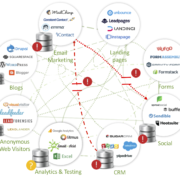
During my three decades in sales leadership roles at large enterprises, early-stage growth companies, and my management consulting practice, I have witnessed and corrected many bad sales practices. These practices, if not course-corrected, would lead to zero sales. When they numbered an even ten, they became Sherwin’s 10 Deadly Sins of Sales. Out of the office with senior executives, I would recount them to their great amusement.
1) I’ll pretend to sell… if you pretend to buy. – The Deadly Embrace.
There is nothing Karen, the salesperson, likes more than showing up at the weekly pipeline call with a big potential deal in the hopper. She may become the focus of the call and may even get some hero status (“you will save the quarter with this deal”).
And, there is nothing more Charlie, “the buyer,” likes more than the salesperson’s attention as “if” he was an important guy making a big decision. In truth, Charlie is 4-levels down the food chain. Charlie may tell the salesperson that he is the head of e-commerce strategy, but he holds no decision-making authority and little influence.
“Charlie and I went to lunch today,” says Karen, and he is favorable to us!
But they are in a deadly embrace of interests. Karen wants nothing more than to say she is selling to the head of the e-commerce strategy, and Charlie wants nothing more than to be considered an influential and key decision-maker.
BOTH are wrong.
2) Not yet, I’m still preparing.
Mike, a meticulous salesperson, has a reasonable pipeline. He does a mountain of preparation, evidenced by a huge stack of color-coded manilla folders on his desk. These are full of extensive background, organization charts, 10Q’s and news articles that he’s gathered on his prospects.
If you ask Mike if he has had meetings with the prospects and what he learned first-hand, he will say “I’m preparing to do that”. It’s an endless endeavor, and he’s never ready to actually sell.
3) Not yet… I’m not done consulting.
Rick, a partner at a major consulting and solutions company, has been calling on the CEO of a major insurance company in Philadelphia. Rick is very knowledgeable about the company’s insurance policy administrative systems. He is thrilled to engage in great discussions with the insurance company’s CEO. Proudly wearing his consulting hat. Proudly acting as a trusted advisor.
After 2 ½ months, I asked Rick if he’d yet proposed a consulting assignment to the CEO and asked for the business. Of course, that was not the case.
So, Rick approaches the CEO and asks for an order. The CEO responds: “I don’t get involved in that decision. It’s Mary Carlson. Talk to her.”
Well, it turns out that Mary already made a consulting partner choice six weeks ago;
Rick had missed the window of opportunity, spending all his time in consulting mode, brandishing his knowledge with the CEO and not selling.
4) My idiot customer just doesn’t get it.
At a recent sales meeting, a sales team member complained that an “idiot customer” prospect doesn’t get our company’s solutions.
I responded, saying this is hardly true. It is your job to make them get it. You need to help them understand how our firm’s value proposition and solutions align with their needs.
“They don’t get it” is our problem to solve, not the customer’s.
5) Wait right there; let me get the “real salesperson.”
At a major consulting company, they had what they called “lead finders” – they may know how to generate leads and sell but they are hardly subject matter experts (“SME’s”). Their role is to find opportunities and bring in the SMEs who know the topic. But these subject matter experts have few selling skills. Their goal is to be smart on the topic at hand. If I asked them, “who are the decision makers, what are the decision criteria, who are the influencers, what are the competitive threats, and how do we mitigate them? Do we know the underlying business case, what the call to action is, and what our unique value proposition to the client is? The SME does not know. They only know that they are one of the smartest folks in the room on the topic.
Some salespeople call in the expert to a sales meeting and essentially relinquish control. The lesson to the salesperson is that you have to know enough about the subject matter or lose it to a specialist. Alternatively, the salesperson and expert can be joined together on an account plan.
6) So what …who cares?
I had a hard-driving mentor, Duane, who taught me everything I needed to know to become a sales leader. I would run through a client pitch with him and he would remark ‘so what…who cares’ after everything I said.
This drove home the need to get the point or the salient issue of the client, tease out real messages that align what you are selling with the client’s need, the pain point.
7) My hygiene is great; leave me alone.
A major consulting company enjoyed a lucrative multi-million dollar deal with a major investment company. The consulting firm did everything right for the account – The single project they had was on time, on budget, profitable, etc. In other words, the hygiene was great.
But the question became what other services have been pitched to the account, what new buying centers have we explored, what new buying executives have we built relationships with, what’s our share of their spend in related areas, and is the company providing any sole sourced business to us beyond the existing project?
The client’s total applicable spend was only 12% of wallet share on related activities. No cross-selling or upselling had been done, and the client wasn’t a business referral source.
Yes, the project “Hygiene” was good, but the account “Health” was less than optimal. There were many other needs we were leaving on the table.
8) I’m selling for a hypothetical company.
There’s always someone on the team who will exclaim…’If only we had this or that, we could win more deals.’ My response is, “You have to sell for us, not for a hypothetical company!”
What we have to do is just that. What the client’s problem is needs to be framed in those terms. Please pass along your insights on what we should have but sell what we do have.
9) Let’s keep investing … one day we’ll win this deal!
It’s very hard to let go of a prospect you’ve worked so hard to pull in and invest in.
The two hardest things in sales are where I start (I have an opportunity, what do I do) and when I stop (the opportunity is low probability, stop expending resources).
We may have to fly four people to a meeting in Omaha. If it were your personal money, would you spend it?
10) If I had a hammer, you’d have nail
If your only tool is a hammer, then every problem looks like a nail. We know from #8 that we need to sell what we have, but it starts and ends with solving the client’s challenge.
Sherwin Uretsky is a Managing Partner with Revenue Architects. He helps businesses transform their front office, drive sales, and build sustainable revenue growth. Contact Sherwin at suretsky @ revenuearchitects.com.











